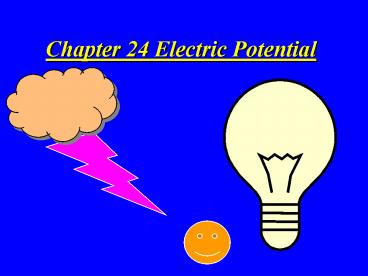Chapter 24 Electric Potential - PowerPoint PPT Presentation
1 / 21
Title:
Chapter 24 Electric Potential
Description:
... speed by applying a force you increase its kinetic energy ... The work done by a resultant force changes the kinetic energy of an object. More Generally ... – PowerPoint PPT presentation
Number of Views:55
Avg rating:3.0/5.0
Title: Chapter 24 Electric Potential
1
Chapter 24 Electric Potential
2
Relationship between Work done by a force and
ENERGY
- If you accelerate an object to a greater speed by
applying a force you increase its kinetic energy - These changes in KE are due to energy transfers
you transfer energy from yourself to the object
you do work
Doing Work on a Penguin
3
Work done by a CONSTANT resultant force on a
Penguin in one dimension
4
Definition of Work
- Represented by area under a force versus distance
graph e.g. in 1-dimension
5
Gravitational Force and Gravitational Potential
Energy
Work done raising an object of on a falling
penguin is independent of path depends only on
the endpoints of motion!!!!!!!! Can define a
Potential Energy Function-U(y). Depends only on
position
6
CONSERVATION OF MECHANICAL ENERGY
7
Work Energy Theorem
- The work done by a resultant force changes the
kinetic energy of an object
More Generally
8
Work and ELECTRIC POTENTIAL Energy
- Energy considerations and the Electric Field
- Consider a point charge qo in an electric field
E. - Apply the definition of work
9
Work due to a point charge moving in the presence
of another point charge
- Example Calculate the work done moving point
charge from A to B in the presence of a field due
to a point charge.
Substituting for the expression for the point
charge
10
Work due to a point charge moving in the presence
of another point charge
The work done moving the charge in the presence
of this field depends only on the endpoints. This
is the behavior of a conservative force (or
field). It is true for any arbitrary charge
distribution.
11
The Electric Potential Difference
- The electric force is conservative
- Potential energy can be defined according to
Divide by test charge to determine change in the
potential energy/charge or potential difference
DV Electric potential Joules/Coulomb volts
(v) Note the electric field can now be
expressed in volts/m N/C
12
Electric Potential of Point charges
- Potential energy of a point charge is referenced
to zero. - is chosen to be the zero point due to the
potential energys dependence on 1/r - The potential at P due to several charges may be
found by first finding the due to each charge and
adding SUPERPOSITION - The potential is a scalar and may be added
algebraically for several charges
13
Continuous Charge Distribution and Calculating
the ElectricField
- The electric potential difference for a
continuous distribution of charge is found by
integrating small increments of charge
- The electric field may be found by reversing
the process or differentiating. - Note the mathematical operation is called
finding the gradient.
14
Potential due to continuous distributions of
charge
Charged disc
Line of charge
15
The Electric Potential Difference
The point charge
The infinite uniform line of charge
The infinite uniform non conducting sheet of
charge
16
Energy change from moving a charge in a uniform
field
- Since the charge experiences a net force applied
by the field, work is done, and the kinetic
energy of the charge changes.
Conservation of Energy applied to motion of a
charge
17
The Electron Volt
- A unit of energy is the electron volt which is
defined as the amount of energy an electronic
charge gains when accelerated through a potential
difference of one volt. - 1eV 1.602 10-19 J
18
Equipotential and Field Lines
Note that the field lines and the equipotentials
are at right angles.
19
Equipotential Surfaces
20
Equipotential and Field Lines
21
Example of Conductors































